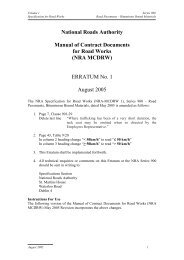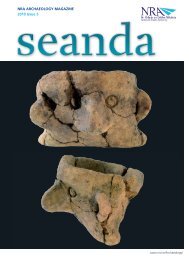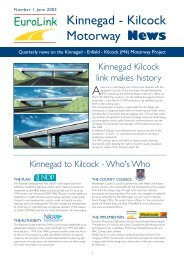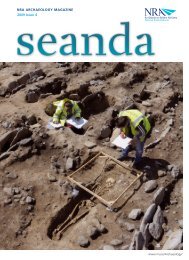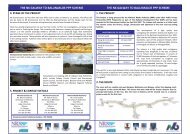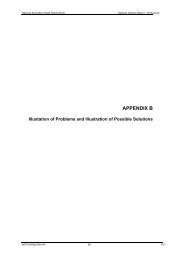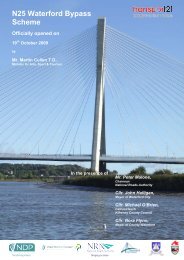ROAD PAVEMENTS – BITUMINOUS BOUND MATERIALS Contents
ROAD PAVEMENTS – BITUMINOUS BOUND MATERIALS Contents
ROAD PAVEMENTS – BITUMINOUS BOUND MATERIALS Contents
Create successful ePaper yourself
Turn your PDF publications into a flip-book with our unique Google optimized e-Paper software.
Volume 2 Series NG 900<br />
Notes for Guidance on the Specification for Road Works Road Pavements <strong>–</strong> Bituminous Bound Materials<br />
loss of volatile oils, which would only take<br />
place after many months on the road. The<br />
results for these samples may be more<br />
variable as homogeneity is not ensured, but<br />
this may be more representative of the<br />
condition immediately after application.<br />
3 Fine mineral or organic matter in modified<br />
binders containing more than 20% by weight<br />
and/or where particles or fibres exceed<br />
dimensions greater than 40% of the plate gap<br />
may not provide true values. However,<br />
repeatable results have been achieved for<br />
Lake Asphalt (36% fine filler) and polymer<br />
modified binder/filler mixtures used in the<br />
manufacture of asphalt of up to 50% by weight<br />
of filler. The behaviour of binder/filler<br />
mixtures is critical in predicting the<br />
performance of asphalt.<br />
4 Most rheometers operate using an air bearing;<br />
to avoid damage, the air supply to the bearing<br />
should be switched on before the instrument is<br />
switched on. When not in use the spindle<br />
should be secured. Such instruments should<br />
not be operated without air.<br />
5 A rheometer should be used that is capable of<br />
controlling the temperature of both the top<br />
and bottom of the sample to prevent<br />
temperature gradients within the sample for<br />
the equilibrated temperature test method and<br />
minimise any temperature gradients for the<br />
temperature sweep method.<br />
6 When the rheometer uses water or other<br />
liquid as the temperature control mechanism,<br />
it is advisable to use glycol or a mixture of<br />
glycol and water for low temperature work<br />
(below 5°C).<br />
7 Caution needs to be exercised in the selection<br />
of the plate geometry in order to be assured of<br />
achieving accurate results. If not known, the<br />
operational limits of stiffness should be<br />
determined for each plate geometry in each<br />
DSR (either by the manufacturer or the<br />
operator). Measurements carried out beyond<br />
the limits will give increasingly inaccurate<br />
results. Software correction to the stiffness<br />
may be acceptable providing appropriate<br />
validation is available.<br />
8 Gap settings within the range 0.5 mm to 2<br />
mm and strain settings within the range 0.005<br />
and 0.02, have been found to be suitable for<br />
typical proprietary bituminous binders over<br />
the temperature range -5°C to +60°C at 0.4 Hz<br />
for parallel plate geometries (up to 80 o C for<br />
some elastomeric modified binders). The gap<br />
set will change with temperature and<br />
appropriate steps will need to be taken to<br />
account for these changes. If the DSR has<br />
automatic gap compensation feature then the<br />
gap may be set at any temperature within the<br />
range to be covered. If the DSR has no gap<br />
compensation feature, the gap should be set at<br />
the mid temperature of the range to be<br />
covered. A suitable means of correcting for gap<br />
changes should be used; one way is to gap at<br />
each temperature, another is to apply<br />
software corrections.<br />
9 Depending on the rheometer used and the<br />
sample being tested, it may be possible to<br />
measure all the results using a single plate<br />
geometry (diameter and gap). The amplitude<br />
of the oscillation of the moving plate of the<br />
DSR should be such that the sample<br />
deformation is within the linear region of the<br />
material being tested. The rheometer operator<br />
should know the limitations of the instrument<br />
and use more than one plate and/or gap if<br />
necessary to cover the range for G* at 0.4 Hz<br />
of at least 20 MPa to 2 kPa.<br />
10 The check that the test is being carried out<br />
within the linear range is most conveniently<br />
made by carrying out a strain sweep at both<br />
the highest and lowest temperature to be used<br />
for the rheological characterisation.<br />
11 11 It has been found convenient to test at<br />
(approximately) the following temperatures as<br />
the minimum number needed to generate<br />
curves required: -5°C, 5°C, 15°C, 25°C, 35°C,<br />
45°C and 60°C. In order to provide the<br />
temperature value within the range of results<br />
for the High Equi-stiffness Temperature some<br />
binders may require testing at temperatures<br />
above 60°C so a further frequency sweep at<br />
70°C or higher may be necessary. The<br />
accuracy of ± 0.5°C is a maximum, the target<br />
temperature range should be nearer ± 0.1 C.<br />
Eleven equally spaced logarithmic frequencies<br />
including 0.1, 0.4, 1.6 and 10 Hz have been<br />
found to be acceptable. Where the DSR used<br />
has pre-set frequencies as close an<br />
approximation to even logarithmic spacing<br />
should be used as is possible.<br />
12 Errors may be introduced by machine<br />
limitations, which should be checked with the<br />
rheometer manufacturer, for example:<br />
i) At low sample stiffness, the minimum<br />
torque that the instrument can generate<br />
and measure accurately may be too high<br />
to keep the sample in its linear region.<br />
ii) At 25°C and at a frequency of 0.4 Hz the<br />
strain should be typically maintained in<br />
the range 0.005 to 0.02.<br />
iii) At high sample stiffness, the maximum<br />
torque that the instrument can generate<br />
may be insufficient to deform the sample<br />
by the minimum amount that can be<br />
measured accurately.<br />
iv) At high sample stiffness, the spindle of<br />
the moving plate may deform due to<br />
spindle compliance, causing an error in<br />
the measurement of strain.<br />
January 2010 23 23






